
A proposed pilot program to expand veterans’ access to assisted living is an “economically sound and sensible approach” to demonstrating the benefits of the setting, according to the American Seniors Housing Association.
The “Expanding Veterans’ Options for Long Term Care Act” would create a three-year pilot program at six Veterans Integrated Services Networks, including at least two program sites in rural areas and two in state veterans homes.
“Assisted living offers the best of personal and supportive care services with a team of professionals in a home environment, where individuals can continue to live a meaningful life that promotes social engagement, nutrition and well-being,” Schless wrote in a letter to members of the Senate Committee on Veterans’ Affairs.
Citing figures about the growing population of older adults, Schless said that people are living longer and will have greater long-term care needs. But almost four in 10 older adults expect to rely on Medicare to pay for long-term care, and one in three have done little or no planning for their care needs.
“As a country, we must prepare for this demand for long-term care options, and this bill presents an opportunity to highlight through this pilot program the critical need for quality settings, such as assisted living, that are also cost-effective,” Schless said. “In addition to the many benefits to the seniors who live in an assisted living community, the cost of this setting remains the lowest among the various options for care.”
Schless said that although ASHA broadly supports the bill, he offered recommendations to provide additional clarity to the program and expectations.
At the conclusion of the pilot program, ASHA recommends allowing veterans to transfer to a similar eligible assisted living community to allow for geographic preferences and for other reasons. ASHA also recommends soliciting veteran feedback, as well as providing quality measurements for the program.
ASHA also asked the committee to consider additional cost drivers — such as inflationary pressures and workforce shortages — in determining reimbursement rates for assisted living communities that participate in the pilot program. As it now stands, the bill proposes a pay rate below the average rate paid for placement in a community nursing home, the association said.
Although the proposed pilot program is only open to Medicaid-certified assisted living settings, Schless told McKnight’s Senior Living that he is confident the “benefits of senior living will be clear and hopefully be expanded for additional time in order to meet the growing demand from the aging population.”
The pilot, he added, presents the senior living industry with the opportunity to qualify care received and quantify savings to the Department of Veterans Affairs on the benefits of assisted living, as well as create more awareness among policymakers about the setting’s value proposition.
ASHA is working with legislators on the bill and will activate its grassroots advocacy program to support it, Schless said.




